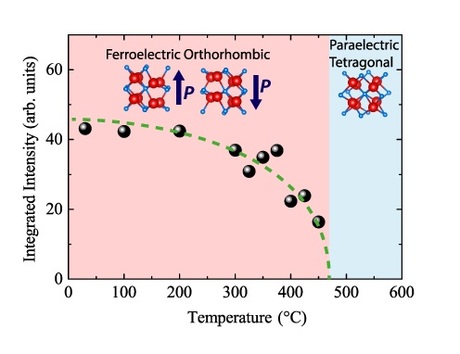A ferroelectric material for miniaturised devices

Japanese scientists have demonstrated the potential of a new, thin-film ferroelectric material that could improve the performance of next-generation sensors and semiconductors. Their work has been published in the journal Scientific Reports.
Ferroelectric materials can switch between different states of electrical polarisation in response to an external electric field. This flexibility means they show promise for applications such as electronic devices and computer memory. But while current ferroelectric materials are valued for their thermal and chemical stability and rapid electromechanical responses, their crystal structure does not allow them to be scaled down to a small, ultrathin film for use in miniaturised devices.
Now, Hiroshi Funakubo has led colleagues at the Tokyo Institute of Technology and other institutions in experiments to determine the ferroelectric properties of an inorganic compound called hafnium oxide (HfO2) for the first time. The crystal structure of HfO2 allows it to be deposited in ultrathin films, meaning it may prove invaluable for next-generation technologies.
Ferroelectric properties stem from the shape and structure of the crystal used. The team knew that an ‘orthorhombic’ crystal of HfO2 would likely exhibit ferroelectricity, as the material had previously been predicted to exhibit ferroelectric properties through first-principle calculations. However, no research team had confirmed and examined these predictions through experiments.
Funakubo’s team wanted to pinpoint the material’s spontaneous polarisation and the Curie temperature (the point above which a material stops being ferroelectric due crystal re-structuring). To do this, they needed to grow a carefully ordered thin-film crystal on a substrate, a process known as epitaxy, which would give them well-defined data on an atomic scale for the first time.
The researchers found that one particular epitaxial film, labelled YHO-7, exhibited ferroelectricity with a spontaneous polarisation of 45 µC/cm and a Curie temperature of 450°C (see image). A Curie temperature of 450°C is of great interest, because it means the material could fulfil functions for future technologies.
The thin film is said to be the first ferroelectric material compatible with silicon-based semiconductors (Si-based CMOS), as well as being robust in miniature forms. The researchers hope the material will have applications in novel random-access memory and transistors, along with quantum computing.
Nanoscale pixels to advance augmented reality eyewear
Physicists have developed extremely small pixels that can be used in compact AR glasses, using...
Novel semiconductor shows superconducting promise
Researchers from The University of Queensland have demonstrated superconductivity in...
Light-controlled ferroelectrics for future electronics
Researchers have discovered a way to manipulate the properties of ferroelectric materials quickly...






